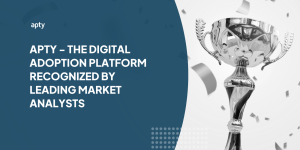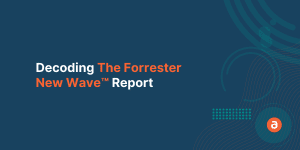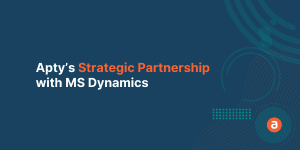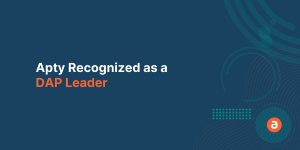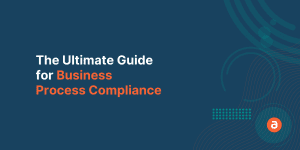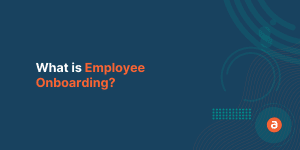Digital Adoption in the age of technology sounds like a cakewalk, doesn’t it? Sadly, the reality is far from that. The exponential growth of software applications has made it easier for companies to purchase new software and has increased the need for effective usage and adoption.
As companies add more software, they’re struggling to train and equip users. Software purchases alone don’t make employees productive – effective onboarding and Digital Adoption do. If an application is not leveraged properly then your investment in a new application will go in vain.
To see a return on their investment in technology, companies must:
- Fully utilize new software and digital tools
- Leverage technology to update their processes
- Change the way they interact with customers and employees
In short, enabling your users and employees to attain Digital Adoption is an essential part of business success.
In this guide, we are going to discuss Digital Adoption in detail and we will cover the following:
What is Digital Adoption?
Digital Adoption means attaining a state where an individual is capable enough to utilize an application, software, or tools to its fullest capacity or the potential to carry out a variety of digital processes.
For example:- Let’s say you are using an iPad. You are utilizing it to browse the internet and nothing else. The same tablet could be used to find directions, book resorts, order food, play games, or complete work from spreadsheets to coding.
In this case, Digital Adoption is not being achieved as the device is not being utilized to its fullest potential; it is just being utilized for Google searches.
Similarly, if a business’s software and tech stack are not leveraged to their fullest potential then Digital Adoption is not achieved.
Digital Adoption Journey of a User
Once users achieve Digital Adoption, they become power users. It’s more than just adopting the software. Software adoption is learning to use new software. Digital adoption is learning how to use it to transform the way you do business.

To unlock the potential of new technology, the user has to understand the following:
- Why is the application or technology required in the first place?
- How it will be useful for our business processes?
- How do our processes need to change to utilize the technology?
- How do you use the technology to achieve the end goals?
- How can processes be optimized?
If the user can find answers to the above-mentioned question then, in that case, the user has achieved Digital Adoption.
Why is Digital Adoption Needed Now?
We have seen a lot of changes in recent times with regards to how business is being conducted because of technological advancements and natural calamities.

Today organizations are more interested than ever to utilize new tools and applications to optimize their business processes and enhance their performance to get more out of their investment.
These new changes often occur when an organization goes under Digital Transformation. As the name suggests, it enables transformation across the organization to shift from the old way of doing things to the new ways of doing the same.
This can only be achieved if an organization understands the technical and cultural needs of different departments and implement the necessary change accordingly. To enable a smooth transition, organizations will need to consider deploying:
- Classroom training,
- Online training
- Knowledge transfer
- Documentation
- Digital Adoption Platforms.
Why Digital Adoption is Important?
Businesses have met unforeseen challenges and disruptions in the last 2-3 years which enforced organizations to opt for the digital route. Today, over 65% of the world’s economy is digital and by 2023 the digital transformation investment is expected to hit $6.8 trillion.
The number of applications used by these organizations in the last few years has increased drastically and the rate of acquiring software is not going to reduce any time soon. These new-age applications are enabling efficiency, agility, productivity, and most important all- improvement in ROI.
However, companies are wasting 37% of their software spending. In the US alone the cost of unused software is $30 billion. It clearly shows that organizations are unable to make most of their application stack.
Many people might say the problem is with the onboarding, training, or even with the software but it can’t be further from the truth.
Organizations must create a digital adoption strategy as it can help them to use their application stack to the fullest potential. If your employees are using only a few elements of an enterprise application then the business might fail to realize the value that they intend to generate from the application investment.
The benefits of having a digital adoption strategy are-
- Helps employees to focus on their actual job.
- Eliminates the need to remember every step to accomplish a task.
- Ensures quicker onboarding, and training.
- Boost the software adoption rate.
- Helps organizations to stay competitive.
- Enables organizations to use any application to its fullest.
Digital Adoption – Why and How to Facilitate it
In the digital era, business and customer requirements change rapidly. Companies usually face a plethora of problems like:
- Resistance across the board while implementing change.
- The workforce generally feels inertia towards transformation.
- Lack of collaboration among departments.
- Poor mindset and lack of preparedness

All these problems mount to the failure of Digital Adoption in more than 70% of the organizations, according to McKinsey research. The cycle for change is getting shorter and shorter as we speak.
Organizations must speed up to adopt new applications and master the existing ones as soon as possible. But doing so will require skills an organization’s users may lack. So, to counter these problems companies must focus on upskilling existing employees and enabling tools that make Digital Adoption rapid, smooth and seamless for each job function.
One of the ways to enable digital adoption with a Digital Adoption Platform. Digital Adoption Platforms work alongside your web-based applications to help users with on-screen guidance and contextual help.
Three sides of Digital Adoption
An organization works with its employees, partners, and customers. Digital adoption may look different depending on the touchpoints within the verticals.

So, here we are going to talk about the challenges and how a Digital Adoption Platform can help with:
1. Digital Adoption for Customers
As companies add digital channels and experiences to their customer relationships, some customers may struggle to adapt.
This is especially true for tech products. As companies focus on making their application better for customers, they also risk confusing them with tons of updates that change the product’s user experience. The very thing that was initiated to make the product better for customers becomes one of the biggest hurdles for the end-users.
This can be averted by providing relevant online training to your customers for each update but doing so will not necessarily solve the adoption challenges because:
- These trainings are usually avoided by customers who think it will take too much time.
- Even if they attend training, they’ll likely forget it.
Let’s look at an example: A stock trading platform app usually makes regular updates to its product to make it more effective for its customers.
On-boarding new and existing customers to every update will drain their resources as they have to allocate dedicated support. In most cases, if customers can’t figure something out on their own, they will reach out to their customer support, resulting in an increase in support queries and tickets.
This also presents a challenge for customers. They may be trying to execute a time-sensitive transaction and don’t have time to wait on a response from a support team. These tickets can be drastically reduced by implementing the Digital Adoption Platform. A DAP can provide on-screen guidance to walk people through the updates so they can execute their trades quickly and timely.
2. Digital Adoption for Employees
Every organization depends on its employees to leverage the full power of enterprise applications and other supporting software. Many organizations customize their ERP, HCM and CRM solutions, making it challenging for end-users. For example, even if a new hire has used Salesforce before, they won’t have used it with your configurations and processes.
In most cases, companies rely on traditional training such as classroom sessions for video series. But unfortunately, according to the Ebbinghaus forgetting curve, 70% of what is taught to the employees is forgotten in 24 hours and 90 % of what is taught is forgotten in a month.
As a result, classroom training is also not sufficient for complete Digital Adoption. Creating digital training courses is effective but exhaustive as it takes too much time and effort. Any form of training can be complemented using Digital Adoption Platforms like Apty to counter the forgetting curve and enhance the rate of Digital Adoption in your organization.
The Digital Adoption Platform (DAP) will help employees use the software as it is intended to be used and utilize most of the features by showing them what to do while they’re working in the application.
3. Digital Adoption for Partners
Resellers and other partners are another important stakeholder group in a Digital adoption plan. If you’re changing your system, you need to make sure your partners can use the new system – especially in the case of resellers or distributors. Without them, your product is going to sell.
For example, an auto manufacturer may have thousands of dealers around the globe. These dealers usually place their parts orders based on customer demands. The manufacturer needs inventory management, eCommerce and logistics systems to handle just their parts division.
Training each individual dealership could be a daunting task, but if the company used a Digital Adoption Solution, they can decrease the time and money they’re spending on training. The DAP will guide the user from one step to another with the help of walkthroughs. This will make the job of both partners and the organization simple and easy.
Digital Adoption Challenges
Digital adoption challenges will slow down your business transformation process. You must have an idea in the first place to overcome these challenges. Some of the most common Digital Adoption challenges include:
- Ineffective Onboarding and Poor Training
- Lack of Support
- Integrated Application Used by a User
- Resistance to Change
- Lack of Attention
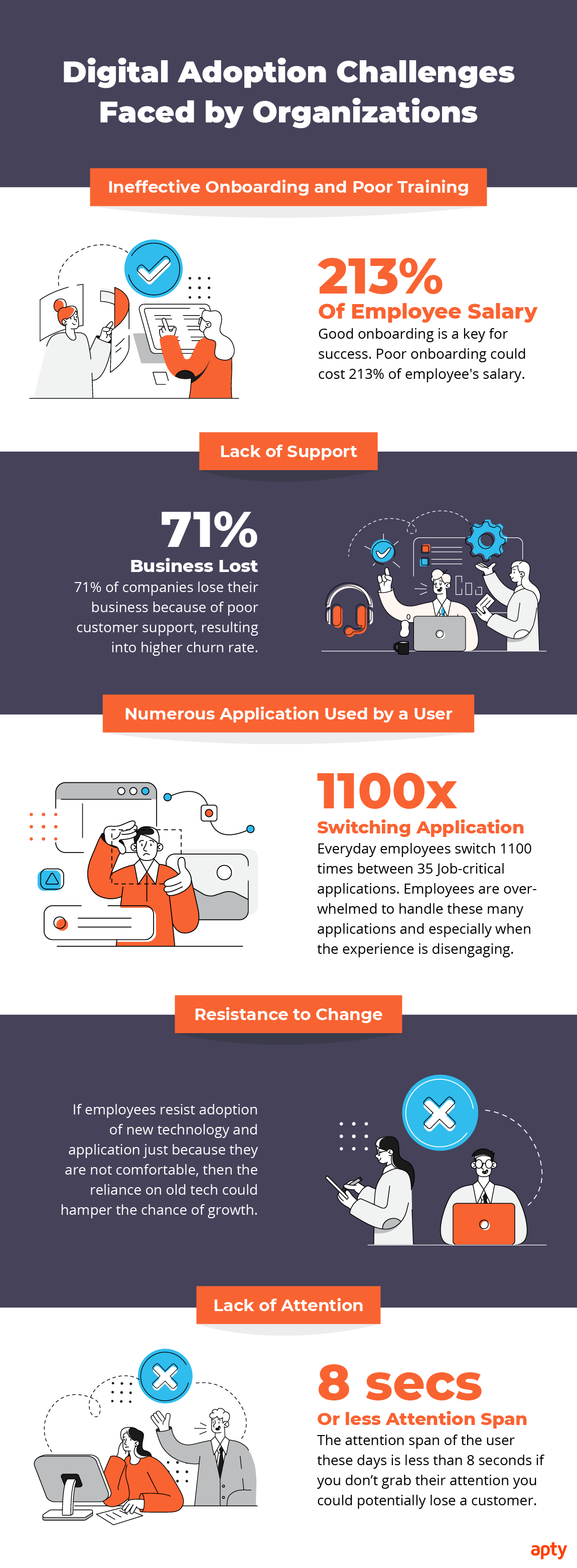
a. Ineffective Onboarding and Poor Training
Whether it’s an employee or a user successful onboarding and training play a vital role in the success of Digital Adoption. Good onboarding is a key for success for any organization, poor onboarding could cost up to 213% of the employee’s salary.
Further good training ensures employee retention and 69 % assurance that an employee will stay for three years if experienced good onboarding experience. In the case of users, they will leave the application if it consumes too much time while onboarding.
b. Lack of Support
Customer support is an integral part of Digital Adoption, most often your customers would like to rely on that support as they want someone to have their back. 71% of companies lose their business because of poor customer support. These are staggering numbers and clearly show the importance of support.
c. Numerous Applications Used by a User
Today, in order to complete their work, employees, use numerous applications. As a result, they get confused or lost. The time consumed to find their way through the software could cost dearly to any organization.
Further, it affects the productivity of the employee. A proper strategy must be in place to make employees comfortable with an application.
d. Resistance to Change
Employees are generally resistant to change, and this is the biggest barrier in Digital Adoption. Change is common for any business; every business migrates from its old system to the new system to catch up with current trends and meet the expected demands.
If they do not change just because they are not comfortable, the reliance on old technology will become a significant disadvantage for the organization.
It is the responsibility of an organization to make sure that employees are on board with the organization’s vision. The organization should further set the expectation and enable resources to make these processes smooth.
e. Lack of Attention
The attention span of the user these days is less than 8 seconds if you don’t grab their attention you could potentially lose a customer. To overcome that create an incredible user experience across the application and increase the engagement rate. To enable this use tools like DAP.
The ultimate 4 steps digital adoption plan
The digital adoption strategy is the backbone of any digital transformation. Most of the organizations give too much emphasis on rolling out their transformation initiatives but often ignore creating a digital adoption plan.
Digital adoption is a continuous process as organizations are always evolving and the way they function changes regularly. As a result, regular training and onboarding could give them a comprehensive outlook but cannot empower them to accomplish their tasks.
To solve this problem we have prepared a digital adoption plan which will help ensure the successful adoption of applications.
- Understand the users: It is important to analyze the user behavior before creating training and onboarding content. With a Digital Adoption Platform businesses can gain insights into how their employees interact with new applications and processes. It helps them to understand whether there is a problem in the process or with the users. Based on these insights the organization can either improve the existing process or create knowledge content that can help the employees overcome the digital adoption challenges.
- Create knowledge content: The analysis in the first step helps the organization to understand the training content requirement of different user groups. By creating personalized content you can enhance the employee experience and indeed their performance. With a digital adoption platform, you also have the flexibility to immediately convert walkthroughs into PDFs, PPTs, SCORM, and videos. This empowers the workforce with a variety of content formats and caters to different types of learners.
- Ensure self-support: Digital transformation brings a lot of change and its core responsibility heavily relies on the IT team to make it a success. This leads to a lot of support calls. Usually, the queries are repetitive and generic. For this, the organization can use tools like Digital Adoption Platform that can house onboarding checklist. This helps the users to keep track of their progress and complete the tasks within a few days. It reduces the reliance on the traditional form of training and reinforces the knowledge again and again. The employees also feel confident as they need not rely on anyone else.
- Measure the outcome: After implementing the digital adoption strategy it is time to monitor the impact. With a Digital Adoption Platform like Apty, you can create goals for all the tasks that the organization expects its employees to complete within the application. You can segment the users based on their job profile, location, and other factors. Based on this organizations can easily track the hurdles that employees face and optimize the processes or guide employees with the walkthroughs to overcome the challenges.
Digital Adoption Best Practices
Digital adoption can become complicated and there is no one thing to go about it but it is always ideal to have a checklist or best practice document by your side to stay on track.
- Analyze the current adoption rate
- Measure the existing process efficiency
- Ensure buy-in from all the stakeholders
- Start with a strategic plan
- Use training and onboarding tools
- Create a digital adoption program
- Track, and measure the outcomes
- Optimize the digital adoption process
Why a Digital Adoption Platform is Important
Digital transformation is one of the most challenging jobs, to achieve this recently the organizations have gone beyond the role of CIO and created a new role called Chief Transformation Officer.
In this CTO role, the executive will make sure the technology is being transformed as intended by the organization. To achieve proper transformation, an organization should have a well-defined agenda, goal and Digital Adoption plan in place. The Digital transformation fails if the implemented application or software is not adopted properly.
So, this makes CTOs and CIOs look for a solution that ensures that the implemented business process is followed properly, and the application is being used to its fullest extent. Hence, DAP (Digital Adoption Platform) comes to a picture. Digital Adoption Platform is an intelligent tool that seamlessly enables digital transformation in any organization.
Never heard of DAP?
Digital Adoption Platforms developed in the last 5 to 10 years as more companies needed ways to facilitate adoption and user onboarding. Most DAP products started by offering on-screen guidance on top of web-based applications.
Today DAP solutions are essential for digital transformation. As applications go through numerous updates, the number of applications needed by one user increases, it becomes a mess for admins, users, and trainers to train each individual based on their job role for each application regularly.
As a result, to reduce dependencies and to make the onboarding process smooth, DAP solutions play a major and vital role. Digital Adoption Solution offers many benefits like it saves your time & money with better employee productivity, uses Analytics to provide better User Experience.
You may have, by now, understood the importance of a Digital Adoption Platform & how it can solve your problems. Given the number of options available today in the market, finding the right DAP for your specific business needs can be a daunting task.
Apty has a different approach than its peers. Apty has a data-centric approach wherein it analyzes how the implemented application is being used and then the walkthroughs are being created based on the bottlenecks faced by the users.
Traditional DAP vs Modern DAP
There are many DAP solutions in the market, they can be categorized into two types:-
- Traditional DAP solutions
- Modern DAP solutions

Traditional DAP solutions first create the walkthroughs and then analyze how those walkthroughs are being used and where are the hangups. The problem is how do you know where users need help? With this approach, you need to guess where exactly your users are struggling while using the applications.
Modern DAP solutions like Apty first analyze how the implemented application is being used, helping you learn your users’ behaviors and their specific needs. Then it allows you to create the walkthrough in a customized fashion for each job function. After that, it analyses how the walkthroughs are being used and based on that analysis, it helps you tweak those walkthroughs. Further based on the analysis, it also suggests and helps you automate parts of the processes using chatbots.
The Way Ahead for Digital Adoption Platforms
Digital Adoption strategies are a must-have for any business to have a competitive edge over its peers. Digital assistance or walkthroughs are becoming an integral part of onboarding for both employees and customers.

The organizations are ensuring their efforts towards Digital transformation are not wasted. Hence, they are moving from LMS to LXP (Learning experience system), they are further making sure there is a guide right next to the user in the form of Digital Adoption Platform (DAP).
In the fast-changing world, DAP will become more and more prevalent. Whether a user in a remote location or within the organization could be guided in a seamless fashion using DAP solutions like Apty.
With solutions like these, your organization is fully prepared for today and tomorrow. The future looks exciting for Digital transformation as Digital Adoption can be achieved easily with the Digital Adoption Platform as a vehicle.
Do you want to know more about the Digital Adoption Platform?
FAQs on Digital Adoption
1. What is digital adoption?
Digital Adoption is the process of attaining a state where an individual is capable enough to utilize an application, software, or tools to its fullest capacity or the potential to carry out a variety of digital processes.
2. Why is digital adoption important?
Digital Adoption is significant as it helps companies realize the value of the software investments made. It optimizes business processes, enhances employee performance and improves ROI.
3. When can we say digital adoption is successful?
Digital Adoption is said to be successful when each individual in your organization is effectively onboarded and uses the organization’s entire tech stack to its fullest potential.

